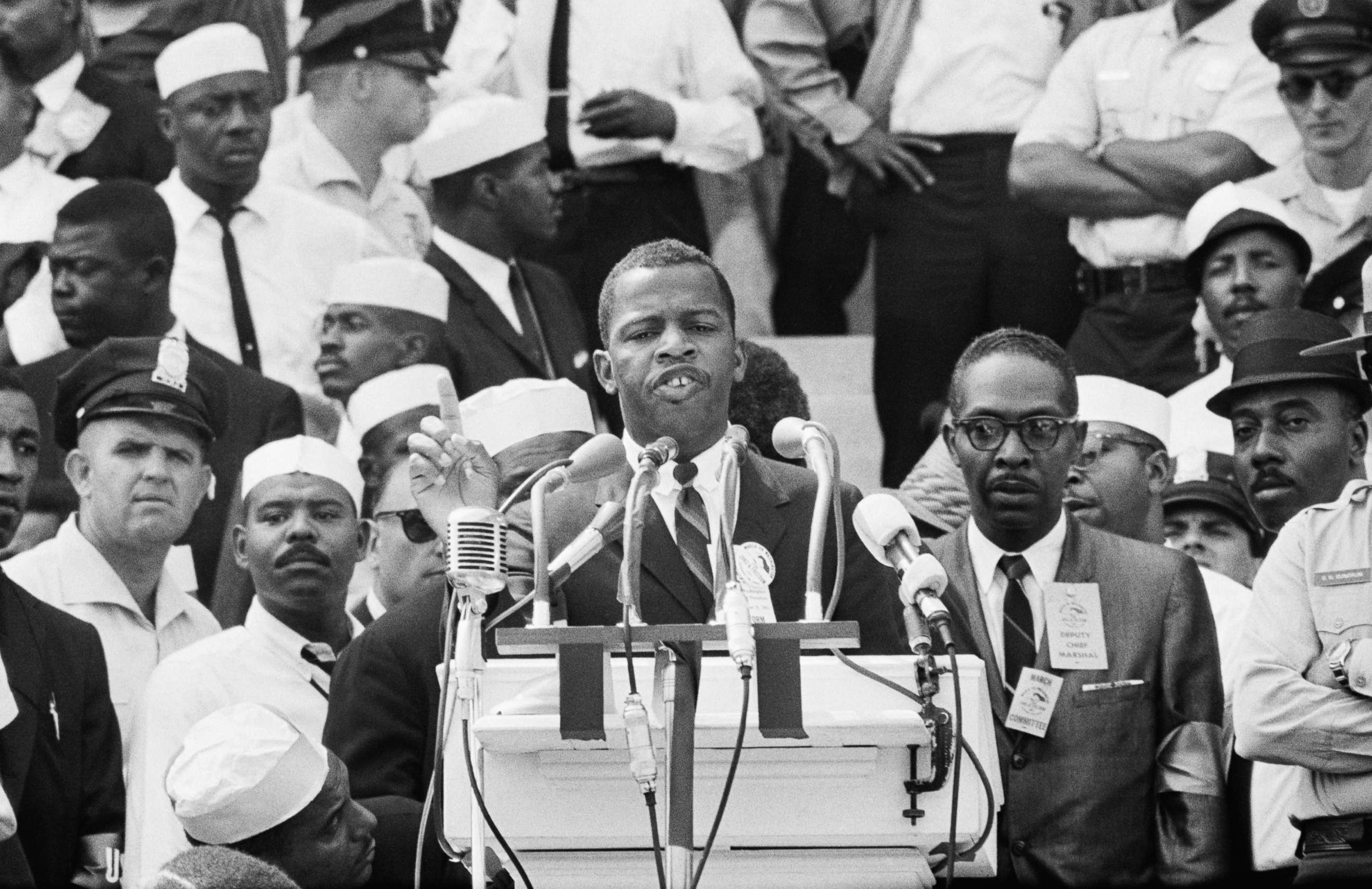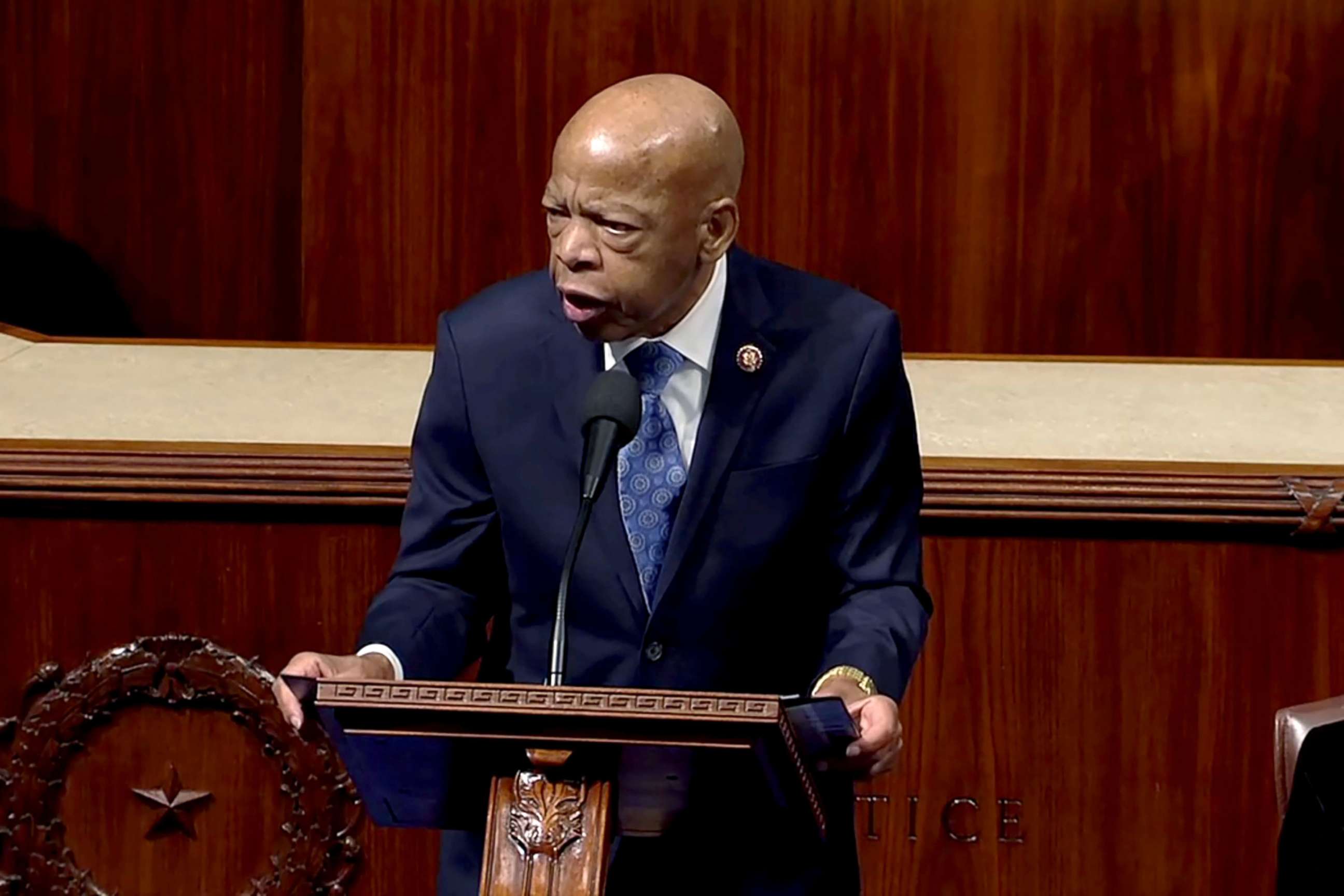The two versions of John Lewis' March on Washington speech reveal the complexity of a young leader
As tributes to the late civil rights icon and Georgia Rep. John Lewis poured in, many recalled his powerful and moving speech at the March on Washington. But while still fiery and poignant, the speech he delivered was considerably less radical than his original draft, which the elders of the civil rights movement encouraged Lewis, 23 at the time, to tone down, according to a historian who spoke with ABC News.
The morning after Lewis died, Angus Johnston, a historian who teaches at the Hostos Community College in the City University of New York, took to Twitter and broke down the changes made to Lewis' original draft.
"Clearly this was a toning down of the speech, clearly the other conveners of the march believed that it was necessary to rein SNCC (the Student Nonviolent Coordinating Committee) in a bit and rein Lewis' speech in a bit," Johnston told ABC News in an interview. "And that's the thing, not every change that was made reflects that impulse but most of them do."
As first reported by the Washington Post, Lewis described the flurry leading up to his March on Washington speech in his 1998 memoir "Walking with the Wind." In the book, Lewis writes that the Archbishop of Washington, Patrick O'Boyle, who was scheduled to give the invocation, read a copy of the original speech and threatened to pull out of the event.
"[The march organizers] said, 'that doesn't sound like you.' That’s what Dr. King said," Lewis recalled to Time Magazine in 2013. "And Mr. Randolph, A. Philip Randolph, said 'John we've come this far together, let's stay together. Can we change that?' This man that I admired and loved. He was my inspiration, my hero. And I had so much respect for A. Philip Randolph."
Johnston, who goes by @studentactivism on Twitter, specializes in American student activism and youth in social movements. He said the story is one of his favorites from the civil rights movement, even though it's not particularly well known.
While he doesn't remember when he first came across the story, in 2011, he shared an annotated version of the delivered speech highlighting the changes to his blog.
Many of the edits to the speech are small, he said, with a single word changed in some sentences or a short phrase added to others. But in some cases, those small tweaks give passages in the speech a new meaning.
Consider one line in the fourth paragraph. Lewis lists objections to the bill that would ultimately become the 1964 Civil Rights Act.
In the original draft, he writes, "this bill will not protect the citizens of Danville, Virginia, who must live in constant fear in a police state." But when he delivered the speech, that "in" became "of."
The change adds ambiguity to the statement and completely transforms the speech, Johnston said.

"In American civic memory of the civil rights movement. We tend to talk about the civil rights movement as being a fight against particular things being denied to black people," he said, citing segregated lunch counters, buses, schools and water fountains. "If that had been all that Jim Crow was about, to be a black person in the South during the period of overt white supremacy would have been a very, very different experience."
"What you see there is that what Lewis was saying was that the experience of these black citizens living in this town in this state in this country, their experience was that they were living in a police state that that was their daily lives," he added. "And that was a reality, which was too scary for Americans to contemplate then and it's frankly too scary for most Americans to contemplate now. And so, it was changed to fear of a police state that they are afraid of the police. They are afraid of the government that they are afraid of something outside of themselves."
In another instance, at the end of the draft speech Lewis encouraged Americans to get involved in "the revolution." "Get in and stay in the streets of every city, every village and every hamlet of this nation until true freedom comes, until the revolution is complete," he wrote in the original draft. When Lewis delivered the speech, he said, "until the revolution of 1776 is complete."
"It is clear that in the original writing of that speech John Lewis and SNCC did not have the American Revolution of 1776 in mind. That was a revolution that left slavery intact," Johnston said. "The appropriating of the revolution of 1776, to say that the civil rights revolution, the revolution of the 1960s, was merely an extension and the completion of the American Revolution--well that's that's a pretty common rhetorical move."
Some historians consider the Student Nonviolent Coordinating Committee, or SNCC, which Lewis was representing at the March on Washington as its chairman, as one of the more radical groups that spoke. The language they used is more associated with later parts of the civil rights movement.
"This was young people, it was frontline organizers, and they were not as connected to the political leadership of the country as some of the other folks were," Johnston said. "They were more impatient and more aggressive in their tactics and their philosophy."
In his memoir, Lewis mentioned that many people within the organization originally wanted nothing to do with the march. Instead of marching, they thought SNCC should engage in more "aggressive action," like staging sit-ins, invading the offices of southern members of Congress and camping out on the White House lawn.
Lewis also said in his memoir he was "incensed" that he was asked to change the speech. "I was angry," he wrote. "But when we were done, I was satisfied. So was Forman. The speech still had fire. It still had bite, certainly more teeth than any other speech made that day."
One of the fiery passages eliminated entirely was a reference to William T. Sherman's march through Georgia in the Civil War.
"The time will come when we will not confine our marching to Washington," Lewis wrote in his original speech. "We will march through the South, through the heart of Dixie, the way Sherman did. We shall pursue our own "scorched earth" policy and burn Jim Crow to the ground — nonviolently."
"People thought we couldn't make a reference to Sherman, and so we deleted that," he said in a 2012 interview with Democracy Now.

On Twitter, Johnston wrote that his mind boggled at the bravery of that line.
"As great as the risk to his own life that his activism already posed, to offer up himself as somebody associating himself with the kinds of struggle that is represented by an allusion to Sherman's March, even with the word non violently included at the end of the sentence, it would have been incredibly enraging to a very, very large number of extremely violent people," Johnston said, noting that at that point in time Lewis' friend and NAACP Mississippi field secretary Medgar Evers had already been assassinated.
"That would have been understood by many in the white community in the South, as a threat of a violent insurrection," he added.
In most of the edits, Johnston said his sympathies were with Lewis and the other organizers of SNCC. There was one instance, however, where he said he sympathized with the people asking for changes.
A paragraph cut from the speech read: "For the first time in one hundred years this nation is being awakened to the fact that segregation is evil and that it must be destroyed in all forms. Your presence today proves that you have been aroused to the point of action."
While we don't know exactly why the section was taken out, Johnston said the line speaks to how young Lewis was at the time.
"Imagine. You're John Lewis. You're 23. You've written that the nation is being awakened to the evils of segregation "for the first time in one hundred years'," Johnston tweeted. "And then A. Philip Randolph puts his hand on your shoulder and looks you in the eye."
Randolph, the president of the Brotherhood of Sleeping Car Porters, convinced President Franklin Delano Roosevelt to issue an executive order banning discrimination in defense contracting by threatening a March on Washington 22 years earlier. The executive order was one of the first major federal actions against discrimination.
Lewis wasn't denying the existence of what came before him, Johnston said in an interview. "He was trying to suggest that in this historical moment, there was an awakening, on the part of white America that had not been seen in, in 100 years and that is that is claim that is not completely outlandish."
Lewis' youth at the time of the March on Washington was part of what inspired Johnston to share the story of his speech.
"A lot of the sharp edges of [the Civil Rights Movement] have been sanded down. We remember the movement as being less confrontational than it was," he said. "John Lewis is somebody who, in his time at SNCC, is one of the people who I regard as one of the real heroes of the civil rights movement. And I thought that this was a way to introduce some of that complexity back into our commemoration of him and to honor this justly beloved elder as the angry young man that he began as."




